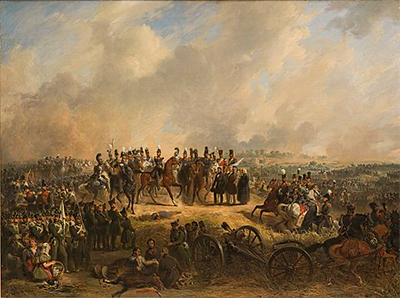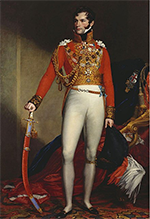King Leopold I of Belgium
Part 2: King and Statesman
The Belgian representative to the U.K. court, Sylvain Van de Weyer, pleaded his case but found deaf ears. His counterpart at the French court, François Lehon, foun rather more success. A large army commanded by Marshal Étienne Gèrard marched straight into Belgium. Estimates are that this army numbered tens of thousands, perhaps even 70,000. Whatever their final numbers, they were more than enough to convince the Dutch force to retreat. The only troops that remained were those in control of the citadel at Antwerp. The Great Powers of Europe that weren't the Netherlands gathered in London and approved Belgian independence. Further, the Dutch king ordered David Hendrik Chassé, his commander in Antwerp, to fire on the city. The ensuing bombardment resulted in the deaths of many people and the destruction of many homes. An exasperated France again sent troops into Belgium, this time besieging the Antwerp citadel. Belgian forces had not stopped fighting during this time, but it took the French infusion to break through. After nearly a month, General Chassé surrendered, on December 23, 1832. William I kept up the pressure, and skirmishes between the armed forces occurred at irregular intervals for another seven years, until by agreeing to terms of the 1839 Treaty of London William I finally recognized Belgium as an independent nation. Leopold had won the war and achieved the peace, but he hadn't necessarily achieved a high level of prosperity for his people. Lingering Dutch resentment over the Belgian independence movement crystallized in the closing of the River Scheldt to Belgian shipping, which severely limited the effectiveness of Antwerp's port. As well, Dutch manufacturers refused to buy Belgian goods, both at home and in overseas colonies. Nonetheless, Leopold and his government found other markets for their goods and introduced a number of economic reforms that helped turn things around to a certain extent. One of the king's successes was the completion in 1835 of the first railway line in continental Europe; it brought needed commerce and tourists to the young country. By 1848, when revolutions consumed other European powers, Belgium was young enough and relatively stable enough that no such overthrow of power occurred within its borders. The army did confront a several-thousand-strong group of radicals, many of whom were armed, but cooler heads prevailed and, after a particularly good harvest, Belgium moved on. Leopold proved adept at managing conflicts between other European powers, both in the political realm and in the matrimonial realm. He encouraged one nephew, Prince Albert of Saxe-Coburg and Gotha, to marry the U.K.'s future Queen Victoria and another nephew, Ferdinand, to marry Portugal's Queen Maria II. He married again, in 1832, to Louise-Marie of Orléans, whose father was the French king, Louis-Philippe. They had four children: Louis Philippe (1833), Leopold (1835), Philippe (1837), and Charlotte (1840). Louise-Marie died in 1850, of tuberculosis. The king was also a strong advocate of Belgian neutrality, which the other powers of Europe had guaranteed in the 1839 Treaty of London. He preferred also not to take sides in conflicts involving other European powers. He steadfastly refused to get involved in the Crimean War, for example. After a long and eventful life, as a soldier and diplomat and monarch, Leopold I died, in Laeken, on Dec. 10, 1865. His oldest son had died in infancy, and so his secondborn son succeeded him, as King Leopold II. First page > Early Life and Soldiery > Page 1, 2 |
|
Social Studies for Kids
copyright 2002–2025
David White



 The new king might have enjoyed the moment, but he had relatively little time to settle in to his role as a constitutional monarch because on August 2, a Dutch army numbering tens of thousands marched across the border, determined to reunite the Low Countries under the banner of the Netherlands. Leopold himself commanded the Army of the Scheldt, one of Belgium's two armies. (The other was the Army of the Meuse.) The more seasoned Dutch army made quick work of the Belgian defense force. The end of the independent state of Belgium seemed imminent. A desperate Leopold appealed for help from other European powers, on August 8.
The new king might have enjoyed the moment, but he had relatively little time to settle in to his role as a constitutional monarch because on August 2, a Dutch army numbering tens of thousands marched across the border, determined to reunite the Low Countries under the banner of the Netherlands. Leopold himself commanded the Army of the Scheldt, one of Belgium's two armies. (The other was the Army of the Meuse.) The more seasoned Dutch army made quick work of the Belgian defense force. The end of the independent state of Belgium seemed imminent. A desperate Leopold appealed for help from other European powers, on August 8.

